 |
JAMES BOND
|
 |
JAMES BOND
|
|
|
|
19
February 2022 |
|
 |
|
The Duke tells the story of the disappearance from London's National Gallery in August 1961 of the recently acquired portrait of The Duke of Wellington by Spanish artist Francisco de Goya. After an extensive worldwide police search and the receipt of several ransom demands, the painting remained unrecovered until July 1965. However, in the interim, the theft of the portrait was still front page news across the UK, and a memorable appearance in the first James Bond film Dr. No (1962) kept the story alive, implying that it was the eponymous villain who had the painting stolen, when in actual fact it was stored in a cupboard in the Newcastle council flat of an unemployed 61-year-old bus driver! At the time, the robbery was believed to have been the work of a gang of international art thieves, and the series of oddly-worded ransom notes posted from different locations in the UK were dismissed by the detectives leading the investigation. |
||||||
|
||||||
|
Goya's painting was originally acquired by the Duke of Wellington himself, and remained in his family’s possession, and had descended to John Osborne, 11th Duke of Leeds by the time it was put up for auction at Sotheby's in 1961. New York collector Charles Wrightsman acquired the painting for £140,000, but questions about such an important work of art being exported were raised in the House of Commons. The portrait was subsequently offered to the National Gallery in London; with the Wolfson Foundation putting up £100,000, and the government adding a special Treasury grant of £40,000, to match Wrightsman's original bid. The painting was first put on display on August 2, 1961 and then stolen just nineteen days later on August 21, 1961. The disappearance of the painting from the National Gallery was the first (and to date only) theft in its 138-year history, and particularly embarrassing as the thief had eluded the sophisticated security devices and exited through an open bathroom window. After a series of ransom demands were received by newspaper agencies in the weeks following the theft, and the later delivery of a label from the back of the portrait, which was identified as genuine, the trail went cold. Following a high-profile campaign in 1965 by the tabloid newspaper the Daily Mirror, a further communication was received which led to the recovery of the portrait, minus its frame, from the left-luggage office at Birmingham New Street Station on May 25, 1965. Six weeks later on Monday 19th July, 61-year-old Kempton Bunton surrendered himself to the police at Scotland Yard in London and confessed that he had stolen the work of art in 1961. Although charged with the theft, Police were still sceptical of Bunton being the prime suspect, considering the unlikelihood of a 61-year-old retiree weighing 17-stone (110 kg) executing the robbery, and then escaping with the portrait via a ladder beneath a small bathroom window! |
||||||
|
||||||
|
Jeremy Hutchinson (1915-2017) [played in The Duke by Matthew Goode], the top criminal barrister whose other famous cases included the Lady Chatterley trial in 1960, and the 1963 Profumo affair, was retained as leading counsel for Bunton. At the time of the trial Hutchinson was married to English actress Dame Peggy Ashcroft (1907-1991). Hutchinson decided to put forward a simple but ingenious defence; the definition of theft at that time required that the defendant should take property belonging to another person with the intention of permanently depriving the owner of it. Hutchinson would contend that Bunton could not be guilty of the offence of theft because he had never intended to deprive the owner (the National Gallery) of the painting permanently. He had merely intended to ‘borrow’ Wellington’s portrait to draw attention to what he considered to be the ‘outrageous’ sum of £140,000 paid for it ‘when so many old-age pensioners could not even afford a television licence’. This followed on from Bunton's campaign in the early 1960s to get free television licences for old-age pensioners in Newcastle. Bunton had already served two short prison sentences for television licence evasion. Despite the plea that he never intended to keep the portrait, whilst in his possession he wrote 5 ‘Coms’ (communications), first to Reuters; and then to the Telegraph Exchange; requesting money. At the conclusion of the high-profile trial, which took place between 4th and 16th November 1965, Bunton was only found guilty of stealing the frame, which had not been returned, and sentenced to three months imprisonment at H.M. Prison Ford in West Sussex. Remarkably however, the story did not end there, when in 2012 it was revealed that Bunton's son John [Jackie] (played in The Duke by Fionn Whitehead) had actually confessed to stealing the portrait himself, after being arrested for an unrelated offence in 1969. The matter was not taken further, and his confession and detailed explanation of how he entered and exited the National Gallery undetected, was buried in police records. |
||||||
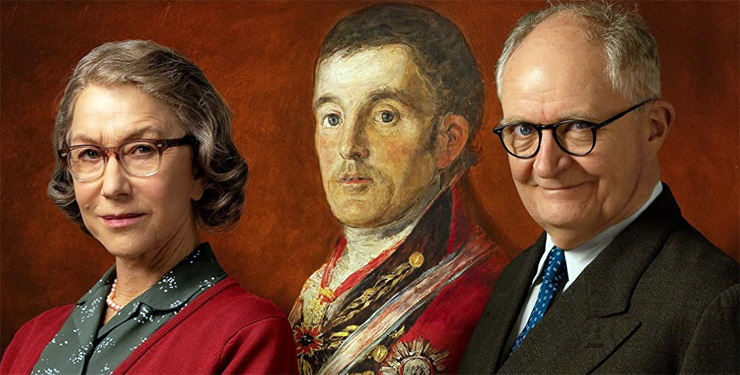 |
||||||
|
The story of the theft of the Goya portrait and subsequent trial of Kempton Bunton is dramatized in the 2021 comedy-drama film The Duke directed by Roger Michell (1956-2021), and starring Jim Broadbent and Helen Mirren (pictured above). The Duke includes a sequence where Bunton and his wife Dorothy watch the scene in Dr. No in which the portrait appears, following his release from prison in early 1966. It was Dr. No co-scriptwriter Johanna Harwood who suggested the inclusion of the Goya painting in the undersea lair of the eponymous villain, and its appearance in the film was enthusiastically received by those cinemagoers who recognised it. After all, the portrait was still missing when Dr. No was first released, just a year after the theft of the work of art. Many reviewers picked up on the reference to the stolen Goya, with Monty Norman's military flourish on the soundtrack also alerting viewers to the painting, as does Sean Connery's subtle double-take as James Bond recognises the portrait. With the ongoing newspaper coverage of the theft in the early 1960s and re-release of Dr. No in 1964, and again on a double-bill with From Russia With Love in 1965-66, the link to the stolen painting was still in the public consciousness, although this has diminished in subsequent years. The Duke re-introduces audiences to the fascinating and unlikely background to the theft in 1961. The Bond filmmakers’ clever integration of a real-life event into the fictional storyline was the first of many ‘in-jokes’ in the James Bond series. However, this was not the only time the James Bond films have featured great works of art as part of a storyline. |
||||||
|
||||||
 |
||||||
|
In the 2012 James Bond film Skyfall - released 50 years after Dr. No, the filmmakers implicated the villain Silva (played by Javier Bardem) in the theft of another masterpiece that was stolen from the Modern Art Museum in Paris in May 2010. Woman with a Fan (1919) painted by Italian artist Amedeo Modigliani (1884-1920) appears in the sequence where Silva's mistress Sévérine (played by Bérénice Lim Marlohe) offers the painting to a potential buyer in Shanghai, only to have him shot through a large window by Patrice (played by Ola Rapace). James Bond (played by Daniel Craig) watches the assassination before a frenetic fight, culminating in the death of Patrice as he falls from the Shanghai skyscraper. |
||||||
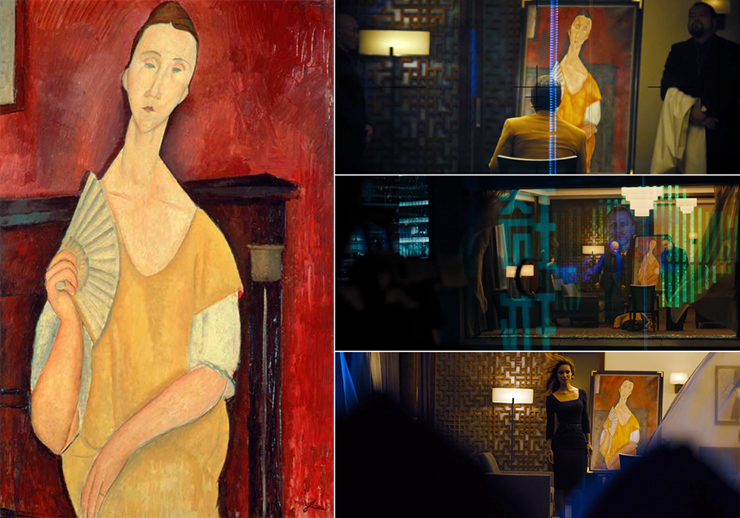 |
||||||
|
Woman with a Fan features prominently in the scene, and is a direct reference to the use of the stolen Goya portrait in Dr. No - one of many references to the fact that the series was then celebrating 50 years in the cinema. Another famous work of art, although never stolen and still on display in Room 34 of the National Gallery in London, is The Fighting Temeraire painted in 1838 by Joseph Mallord William Turner (1775-1851). The painting becomes the focus of the first meeting between Q (played by Ben Whishaw) and James Bond (Daniel Craig), as the two reflect on the work, using the analogy of “...a grand old warship being ignominiously hauled away for scrap...” to symbolize Bond's age, and current standing within MI6. |
||||||
|
||||||
|
Modigliani's Woman with a Fan makes another appearance in the next film in the series Spectre (2015), and can now be briefly seen hanging on the wall of Madeleine Swann's bedroom in Blofeld's Moroccan desert hideout. This appearance now implies that it was Blofeld/SPECTRE behind the Paris art theft in 2010, and reinforces the ever-changing storyline to include the crime organisation as being behind everything in Daniel Craig's tenure as James Bond. One of the other paintings stolen from the Musée d'Art Moderne de Paris was Pablo Picasso’s (1881-1973) cubist canvas Le pigeon aux petits pois (Pigeon with Peas), painted in 1911, and worth an estimated $27-million. This painting can also be briefly glimpsed hanging on the wall of James Bond's bedroom in the same sequence in Spectre (2015). |
||||||
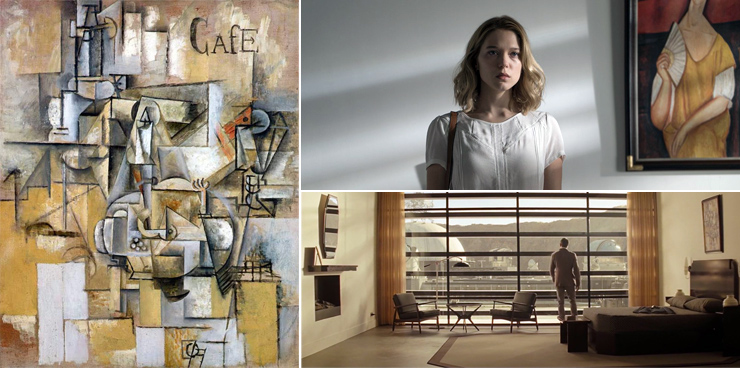 |
||||||
|
The three other paintings stolen in the 2010 Paris robbery were Henri Matisse's La Pastorale (1905), Ferdinand Leger's Still Life with Candlestick (1922), and L'olivier pres de l'éstaque (1906) by French artist Georges Braque. Although three men ultimately stood trial for the robbery, none of the paintings have been recovered, and they are believed to have been destroyed when one of the accomplices panicked and put them in a rubbish bin from where they were ultimately crushed. None of these paintings have appeared in the James Bond films, but one other notable work by Georges Braque did make an appearance in the 1964 classic Goldfinger - and its inclusion was undoubtedly another ‘in-joke’ to get in a subtle reference to the man who ‘gave’ his name to the eponymous villain of the film. |
||||||
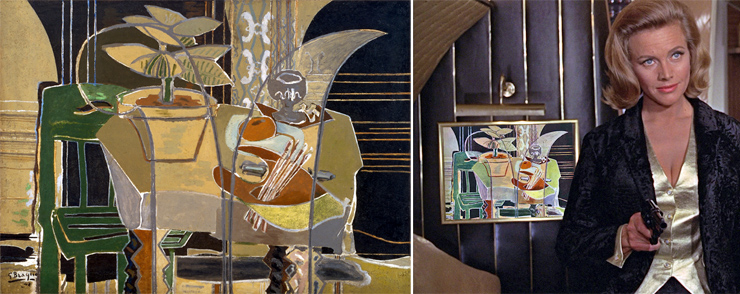 |
||||||
|
Who but someone as wealthy and ostentatious as Auric Goldfinger would decorate their private jet with a $50,000 canvas by cubist painter Georges Braque (1882-1963). Production Designer Ken Adam was undoubtedly responsible for the witty inclusion of Braque's Grand intérieur à la palette painted in 1942 on Goldfinger's private plane, which Ken may well have seen firsthand in 1946 when the painting was exhibited at The Tate Gallery in London; a deft touch that was probably noticed by few but would have certainly delighted any art experts in the cinema audience. The painting is currently worth in the region of $2 million and has been in the Menil Collection in Houston, Texas since 1953. By a strange coincidence (or was it?) Georges Braque was friends with Ernő Goldfinger (1902-1987), a Hungarian-born architect, a designer of furniture, a champion of Marxism, art collector, and a bully who put people in fear. The real Goldfinger was a humourless man given to notorious rages, and he fell afoul of James Bond author Ian Fleming when a number of cottages in Hampstead were demolished to make way for Goldfinger's house; fond of the area, Fleming had been among the objectors to the pre-war demolition of the cottages. A discussion on the golf course with John Blackwell, the cousin of Goldfinger's wife Ursula, prompted Fleming to appropriate their family name for the villain in his next Bond novel. When Fleming's seventh 007 novel GOLDFINGER was published in 1959, Ernő Goldfinger consulted his lawyers with a view to suing Fleming, which prompted the author to threaten renaming the character ‘Goldprick’ (Goldmember anyone?), a name suggested to him by the critic Cyril Connolly. Ernő Goldfinger eventually decided not to sue and Fleming's publishers Jonathan Cape agreed to pay his costs and give him six free copies of the book; one wonders what became of them. Fleming had the last laugh though; he cut the 6ft 2in Ernő Goldfinger down to size - in the novel Auric Goldfinger was only 5ft tall! Having seen much of Goldfinger's architecture in London, it's difficult to know who the bigger villain of the two was! |
||||||
|
||||||
|
James Bond's boss M (played in the films by Bernard Lee, Robert Brown, Judi Dench and more recently Ralph Fiennes) is also somewhat of an art lover, with many paintings appearing on the walls of his London office and Thames-side home ‘Quarterdeck’ in On Her Majesty's Secret Service (1969). Most of these feature ships befitting the Admiral's naval background, but there is one painting in particular that can be singled-out as being featured as part of the narrative of the film. The portrait of ‘King William III at the Battle of The Boyne in 1690’ painted by Dutch artist Jan Wyck (1652-1700) is seen on the wall of M's office in Moonraker (1979). Wyck was renowned for being a specialist at painting horses in battle and hunting scenes, and brought the Dutch equestrian portrait genre to England. The painting in Moonraker is memorably damaged by Roger Moore's 007 as he tests the latest wrist-gun gadget presented to him by Q (played by Desmond Llewelyn), much to the annoyance of M (played by Bernard Lee). Interestingly, Bernard Lee had portrayed William III in the 1937 British historical drama film The Black Tulip. |
||||||
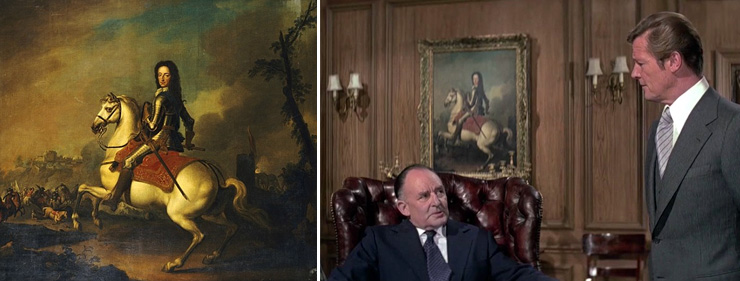 |
||||||
|
Finally, staying with the royal theme, the 1955 painting of Queen Elizabeth II by Italian artist Pietro Annigoni (1910-1988) is mentioned by author Ian Fleming as James Bond first meets Kerim Bay at his Istanbul office in chapter 14 of his 1957 novel FROM RUSSIA, WITH LOVE:
The painting is also seen on the wall of James Bond's (George Lazenby) office as he apologises to Her Majesty after tendering his resignation in On Her Majesty's Secret Service (1969). Her Majesty Queen Elizabeth II would meet James Bond in person in the guise of Daniel Craig in 2012, ‘when they both parachute out of a helicopter’ to make a spectacular entrance at the Opening Ceremony of the Olympic Games in London, in the ‘Happy & Glorious’ segment of the BBC coverage titled ‘Isles of Wonder’ directed by Danny Boyle, who was originally slated to helm Craig's swansong as 007 in No Time To Die (2021). |
||||||
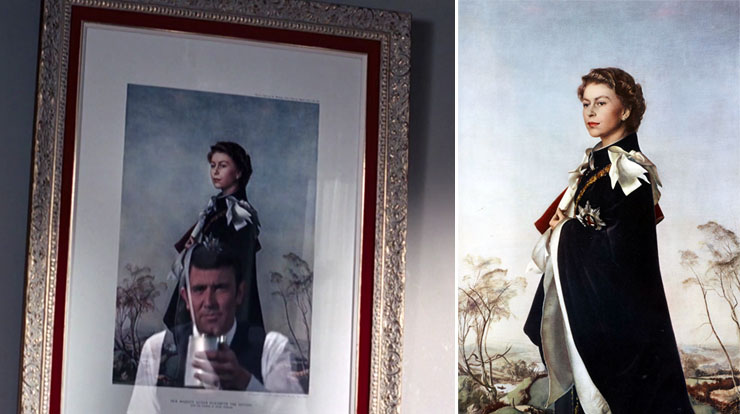 |
||||||
|
||||||||||||
|
|
||||||||||||